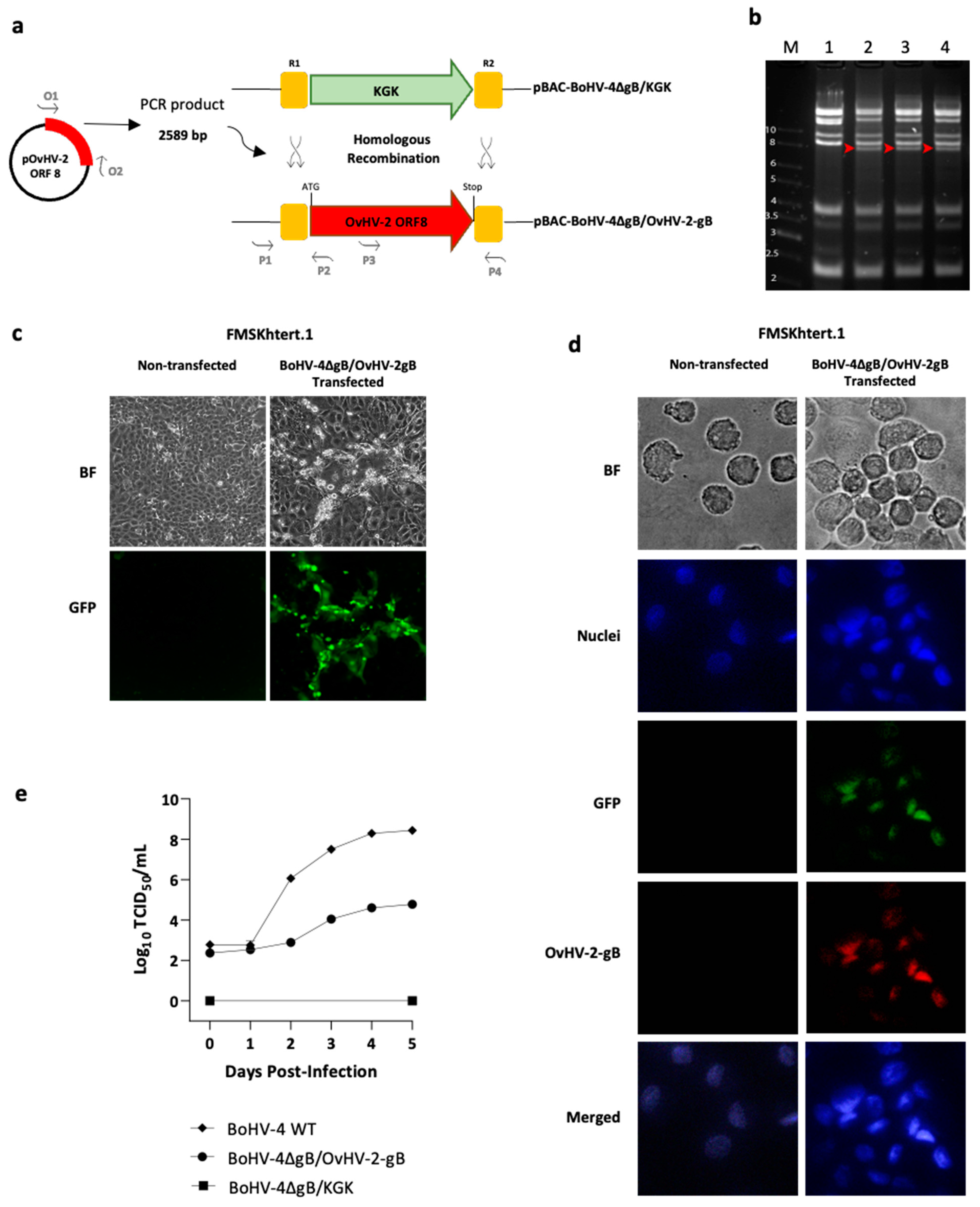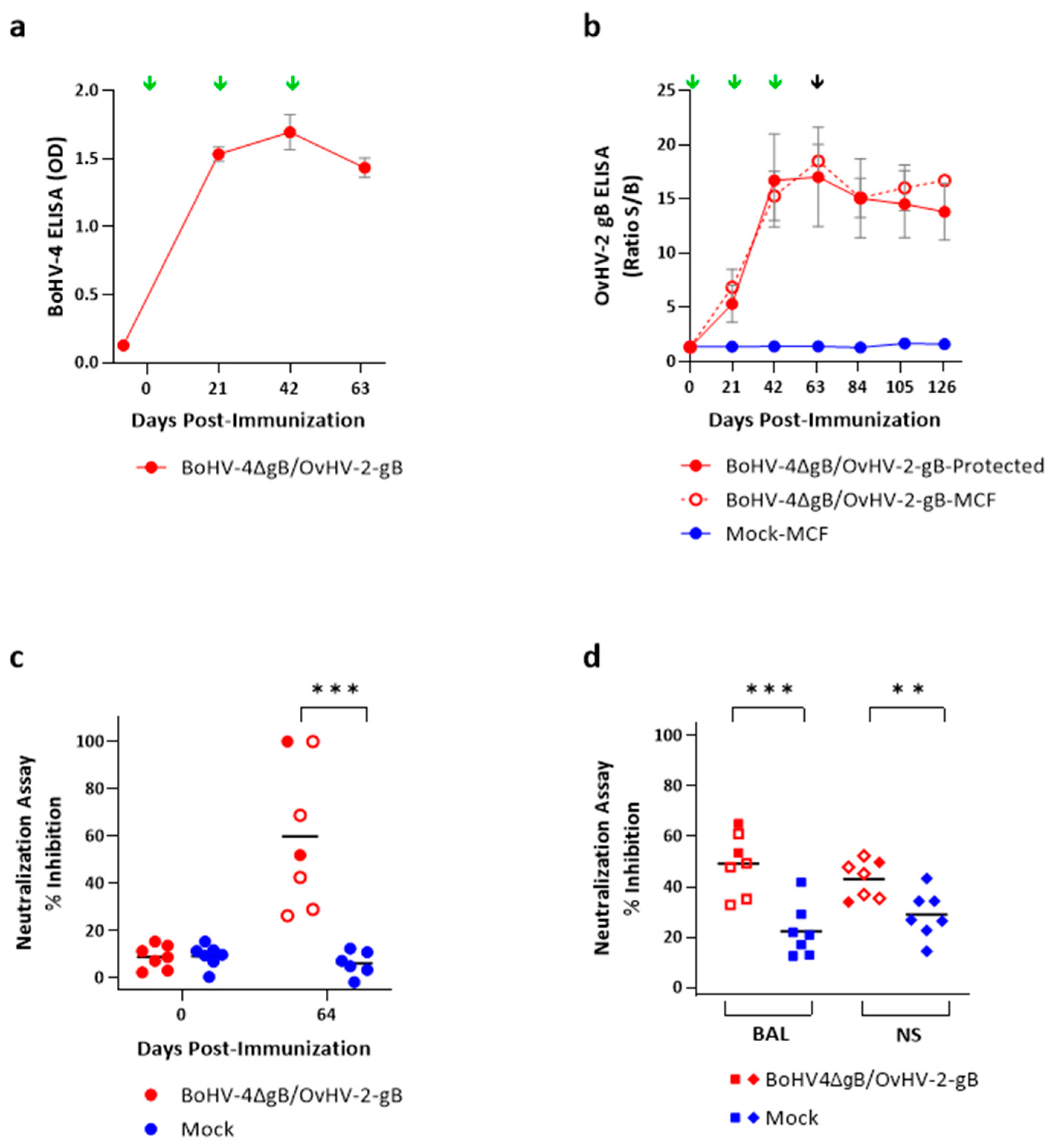Ovine Herpesvirus 2 Glycoprotein B Complementation Restores Infectivity to a Bovine Herpesvirus 4 gB-Null Mutant
Abstract
1. Introduction
2. Materials and Methods
2.1. Construction and In Vitro Evaluation of the BoHV-4∆gB/OvHV-2-gB Mutant
2.1.1. Homologous Recombination
2.1.2. Recombinant Virus Reconstitution
2.1.3. Virus Propagation and Titration
2.1.4. Viral Growth Curves
2.1.5. OvHV-2 gB Expression
2.2. Evaluation of BoHV-4∆gB/OvHV-2-gB as an SA-MCF Vaccine
2.2.1. Immunization, Challenge, and Animal Monitoring
2.2.2. Viral DNA Quantification
2.2.3. Antibody Detection
2.2.4. Virus Neutralization
2.2.5. Statistical Analysis
3. Results
3.1. Virus Construction and Complementation
3.2. Evaluation of BoHV-4/OvHV-2-gB as a Potential SA-MCF Vaccine Candidate
4. Discussion
5. Conclusions
Supplementary Materials
Author Contributions
Funding
Institutional Review Board Statement
Data Availability Statement
Acknowledgments
Conflicts of Interest
References
- Davison, A.J. Herpesvirus systematics. Vet. Microbiol. 2010, 143, 52–69. [Google Scholar] [CrossRef]
- Ackermann, M. Pathogenesis of gammaherpesvirus infections. Vet. Microbiol. 2006, 113, 211–222. [Google Scholar] [CrossRef] [PubMed]
- Li, H.; Cunha, C.W.; Taus, N.S.; Knowles, D.P. Malignant catarrhal fever: Inching toward understanding. Annu. Rev. Anim. Biosci. 2014, 2, 209–233. [Google Scholar] [CrossRef] [PubMed]
- Osorio, F.A.; Reed, D.E. Experimental inoculation of cattle with bovine herpesvirus-4: Evidence for a lymphoid-associated persistent infection. Am. J. Vet. Res. 1983, 44, 975–980. [Google Scholar] [PubMed]
- Connolly, S.A.; Jardetzky, T.S.; Longnecker, R. The structural basis of herpesvirus entry. Nat. Rev. Microbiol. 2021, 19, 110–121. [Google Scholar] [CrossRef] [PubMed]
- AlHajri, S.M.; Cunha, C.W.; Nicola, A.V.; Aguilar, H.C.; Li, H.; Taus, N.S. Ovine herpesvirus 2 glycoproteins B, H, and L are sufficient for, and viral glycoprotein Ov8 can enhance, cell-cell membrane fusion. J. Virol. 2017, 91, e02454-16. [Google Scholar] [CrossRef] [PubMed]
- Möhl, B.S.; Chen, J.; Longnecker, R. Gammaherpesvirus entry and fusion: A tale how two human pathogenic viruses enter their host cells. In Advances in Virus Research; Kielian, M., Mettenleiter, T.C., Roossinck, M.J., Eds.; Academic Press: Cambridge, MA, USA, 2019; pp. 313–343. [Google Scholar]
- Cunha, C.W.; Taus, N.S.; Dewals, B.G.; Vanderplasschen, A.; Knowles, D.P.; Li, H. Replacement of glycoprotein B in alcelaphine herpesvirus 1 by Its ovine herpesvirus 2 homolog: Implications in vaccine development for sheep-associated malignant catarrhal fever. mSphere 2016, 1, e00108-16. [Google Scholar] [CrossRef] [PubMed]
- Backovic, M.; Jardetzky, T.S.; Longnecker, R. Hydrophobic Residues That Form Putative Fusion Loops of Epstein-Barr Virus Glycoprotein B Are Critical for Fusion Activity. J. Virol. 2007, 81, 9596–9600. [Google Scholar] [CrossRef] [PubMed]
- Hannah, B.P.; Cairns, T.M.; Bender, F.C.; Whitbeck, J.C.; Lou, H.; Eisenberg, R.J.; Cohen, G.H. Herpes Simplex Virus Glycoprotein B Associates with Target Membranes via Its Fusion Loops. J. Virol. 2009, 83, 6825–6836. [Google Scholar] [CrossRef]
- Misra, V.; Blewett, E.L. Construction of herpes simplex viruses that are pseudodiploid for the glycoprotein B gene: A strategy for studying the function of an essential herpesvirus gene. J. Gen. Virol. 1991, 72 Pt 2, 385–392. [Google Scholar] [CrossRef]
- Mettenleiter, T.C.; Spear, P.G. Glycoprotein gB (gII) of pseudorabies virus can functionally substitute for glycoprotein gB in herpes simplex virus type 1. J. Virol. 1994, 68, 500–504. [Google Scholar] [CrossRef]
- Franceschi, V.; Capocefalo, A.; Cavirani, S.; Donofrio, G. Bovine herpesvirus 4 glycoprotein B is indispensable for lytic replication and irreplaceable by VSVg. BMC Veter Res. 2013, 9, 6. [Google Scholar] [CrossRef]
- Lee, S.K.; Compton, T.; Longnecker, R. Failure to Complement Infectivity of EBV and HSV-1 Glycoprotein B (gB) Deletion Mutants with gBs from Different Human Herpesvirus Subfamilies. Virology 1997, 237, 170–181. [Google Scholar] [CrossRef][Green Version]
- Miethke, A.; Keil, G.M.; Weiland, F.; Mettenleiter, T.C. Unidirectional complementation between glycoprotein B homologues of pseudorabies virus and bovine herpesvirus 1 is determined by the carboxy-terminal part of the molecule. J. Gen. Virol. 1995, 76, 1623–1635. [Google Scholar] [CrossRef] [PubMed]
- Zhong, L.; Zhang, W.; Krummenacher, C.; Chen, Y.; Zheng, Q.; Zhao, Q.; Zeng, M.-S.; Xia, N.; Zeng, Y.-X.; Xu, M.; et al. Targeting herpesvirus entry complex and fusogen glycoproteins with prophylactic and therapeutic agents. Trends Microbiol. 2023, 31, 788–804. [Google Scholar] [CrossRef]
- Cunha, C.W.; Knowles, D.P.; Taus, N.S.; O’toole, D.; Nicola, A.V.; Aguilar, H.C.; Li, H. Antibodies to ovine herpesvirus 2 glycoproteins decrease virus infectivity and prevent malignant catarrhal fever in rabbits. Veter Microbiol. 2015, 175, 349–355. [Google Scholar] [CrossRef] [PubMed]
- Donofrio, G.; Cavirani, S.; Simone, T.; van Santen, V.L. Potential of bovine herpesvirus 4 as a gene delivery vector. J. Virol. Methods 2002, 101, 49–61. [Google Scholar] [CrossRef]
- Donofrio, G.; Cavirani, S.; Vanderplasschen, A.; Gillet, L.; Flammini, C.F. Recombinant bovine herpesvirus 4 (BoHV-4) expressing glycoprotein D of BoHV-1 is immunogenic and elicits serum-neutralizing antibodies against BoHV-1 in a rabbit model. Clin. Vaccine Immunol. 2006, 13, 1246–1254. [Google Scholar] [CrossRef]
- Donofrio, G.; Sartori, C.; Franceschi, V.; Capocefalo, A.; Cavirani, S.; Taddei, S.; Flammini, C.F. Double immunization strategy with a BoHV-4-vectorialized secreted chimeric peptide BVDV-E2/BoHV-1-gD. Vaccine 2008, 26, 6031–6042. [Google Scholar] [CrossRef]
- Donofrio, G.; Taddei, S.; Franceschi, V.; Capocefalo, A.; Cavirani, S.; Martinelli, N.; Ottonello, S.; Ferrari, M. Swine adipose stromal cells loaded with recombinant bovine herpesvirus 4 virions expressing a foreign antigen induce potent humoral immune responses in pigs. Vaccine 2011, 29, 867–872. [Google Scholar] [CrossRef] [PubMed]
- Franceschi, V.; Capocefalo, A.; Calvo-Pinilla, E.; Redaelli, M.; Mucignat-Caretta, C.; Mertens, P.; Ortego, J.; Donofrio, G. Immunization of knock-out alpha/beta interferon receptor mice against lethal bluetongue infection with a BoHV-4-based vector expressing BTV-8 VP2 antigen. Vaccine 2011, 29, 3074–3082. [Google Scholar] [CrossRef]
- Pedrera, M.; Macchi, F.; McLean, R.K.; Franceschi, V.; Thakur, N.; Russo, L.; Medfai, L.; Todd, S.; Tchilian, E.Z.; Audonnet, J.-C.; et al. Bovine Herpesvirus-4-Vectored Delivery of Nipah Virus Glycoproteins Enhances T Cell Immunogenicity in Pigs. Vaccines 2020, 8, 115. [Google Scholar] [CrossRef]
- Shringi, S.; O’toole, D.; Cole, E.; Baker, K.N.; White, S.N.; Donofrio, G.; Li, H.; Cunha, C.W. OvHV-2 glycoprotein B delivered by a recombinant BoHV-4 is immunogenic and induces partial protection against sheep-associated malignant catarrhal fever in a rabbit model. Vaccines 2021, 9, 90. [Google Scholar] [CrossRef]
- Warming, S.; Costantino, N.; Court, D.L.; Jenkins, N.A.; Copeland, N.G. Simple and highly efficient BAC recombineering using galK selection. Nucleic Acids Res. 2005, 33, e36. [Google Scholar] [CrossRef]
- Cunha, C.W.; O’Toole, D.; Taus, N.S.; Shringi, S.; Knowles, D.P.; Li, H. A Rabbit Model for Sheep-Associated Malignant Catarrhal Fever Research: From Virus Infection to Pathogenesis Studies and Vaccine Development. Curr. Clin. Microbiol. Rep. 2019, 6, 148–155. [Google Scholar] [CrossRef]
- Traul, D.L.; Taus, N.S.; Oaks, J.L.; Toole, D.O.; Rurangirwa, F.R.; Baszler, T.V.; Li, H. Validation of non-nested and real-time PCR for diagnosis of sheep-associated malignant catarrahal fever in clinical samples. J. Vet. Diagn. Investig. 2007, 19, 405–408. [Google Scholar] [CrossRef]
- Lété, C.; Machiels, B.; Stevenson, P.G.; Vanderplasschen, A.; Gillet, L. Bovine herpesvirus type 4 glycoprotein L is nonessential for infectivity but triggers virion endocytosis during entry. J. Virol. 2012, 86, 2653–2664. [Google Scholar] [CrossRef] [PubMed]
- Eisenberg, R.J.; Atanasiu, D.; Cairns, T.M.; Gallagher, J.R.; Krummenacher, C.; Cohen, G.H. Herpes virus fusion and entry: A story with many characters. Viruses 2012, 4, 800–832. [Google Scholar] [CrossRef] [PubMed]
- Pertel, P.E.; Spear, P.G.; Longnecker, R. Human herpesvirus-8 glycoprotein B interacts with Epstein-Barr virus (EBV) glycoprotein 110 but fails to complement the infectivity of EBV mutants. Virology 1998, 251, 402–413. [Google Scholar] [CrossRef] [PubMed][Green Version]
- Cunha, C.W.; Baker, K.N.; O’toole, D.; Cole, E.; Shringi, S.; Dewals, B.G.; Vanderplasschen, A.; Li, H. A Vaccine Targeting Ovine Herpesvirus 2 Glycoprotein B Protects against Sheep-Associated Malignant Catarrhal Fever. Vaccines 2022, 10, 2156. [Google Scholar] [CrossRef] [PubMed]
- Williams, L.B.A.; Fry, L.M.; Herndon, D.R.; Franceschi, V.; Schneider, D.A.; Donofrio, G.; Knowles, D.P. A recombinant bovine herpesvirus-4 vectored vaccine delivered via intranasal nebulization elicits viral neutralizing antibody titers in cattle. PLoS ONE 2019, 14, e0215605. [Google Scholar] [CrossRef] [PubMed]


| Group | Immunization | Protected (%) | MCF (%) | Total |
|---|---|---|---|---|
| Vac | BoHV-4∆gB/OvHV-2-gB | 2 (28.57%) | 5 (71.43%) | 7 |
| Mock | Mock | 0 (0.00%) | 7 (100.00%) | 7 |
| Total | 2 | 12 | 14 |
| Rabbit ID | Group | First Detection of OvHV-2 DNA in Blood by qPCR (DPC) | Onset of Fever (DPC) | MCF (DPC) | OvHV-2 Genome Copies in Lungs (qPCR) | Histological Lesion Scores |
|---|---|---|---|---|---|---|
| 3060 | V | - | - | - | 0 | NVL |
| 3061 | V | - | - | - | 0 | NVL |
| 3062 | V | 17 | 19 | 20 | 8210 | + |
| 3063 | V | 53 | 72 | 72 | 10,900 | + |
| 3064 | V | 20 | 24 | 26 | 34,300 | ++ |
| 3065 | V | 17 | 20 | 22 | 29,500 | + |
| 3066 | V | 24 | 33 | 34 | 47,500 | + |
| Avg (V) | 26.2 | 33.6 | 34.8 | 26,082 | ||
| 3070 | M | 26 | 35 | 36 | 27,800 | + |
| 3071 | M | 11 | 23 | 24 | 19,500 | + |
| 3072 | M | 36 | 49 | 49 | 10,800 | + |
| 3073 | M | 17 | 25 | 26 | 16,900 | + |
| 3074 | M | 20 | 27 | 27 | 35,800 | + |
| 3075 | M | 20 | 27 | 27 | 55,600 | ++ |
| 3076 | M | 17 | 25 | 26 | 25,200 | + |
| Avg (M) | 21 | 30.14 | 30.7 | 27,371 |
Disclaimer/Publisher’s Note: The statements, opinions and data contained in all publications are solely those of the individual author(s) and contributor(s) and not of MDPI and/or the editor(s). MDPI and/or the editor(s) disclaim responsibility for any injury to people or property resulting from any ideas, methods, instructions or products referred to in the content. |
© 2024 by the authors. Licensee MDPI, Basel, Switzerland. This article is an open access article distributed under the terms and conditions of the Creative Commons Attribution (CC BY) license (https://creativecommons.org/licenses/by/4.0/).
Share and Cite
Moré, D.D.; Baker, K.N.; Shringi, S.; Bastos, R.G.; O’Toole, D.; Donofrio, G.; Cunha, C.W. Ovine Herpesvirus 2 Glycoprotein B Complementation Restores Infectivity to a Bovine Herpesvirus 4 gB-Null Mutant. Pathogens 2024, 13, 219. https://doi.org/10.3390/pathogens13030219
Moré DD, Baker KN, Shringi S, Bastos RG, O’Toole D, Donofrio G, Cunha CW. Ovine Herpesvirus 2 Glycoprotein B Complementation Restores Infectivity to a Bovine Herpesvirus 4 gB-Null Mutant. Pathogens. 2024; 13(3):219. https://doi.org/10.3390/pathogens13030219
Chicago/Turabian StyleMoré, Daniela D., Katherine N. Baker, Smriti Shringi, Reginaldo G. Bastos, Donal O’Toole, Gaetano Donofrio, and Cristina W. Cunha. 2024. "Ovine Herpesvirus 2 Glycoprotein B Complementation Restores Infectivity to a Bovine Herpesvirus 4 gB-Null Mutant" Pathogens 13, no. 3: 219. https://doi.org/10.3390/pathogens13030219
APA StyleMoré, D. D., Baker, K. N., Shringi, S., Bastos, R. G., O’Toole, D., Donofrio, G., & Cunha, C. W. (2024). Ovine Herpesvirus 2 Glycoprotein B Complementation Restores Infectivity to a Bovine Herpesvirus 4 gB-Null Mutant. Pathogens, 13(3), 219. https://doi.org/10.3390/pathogens13030219







